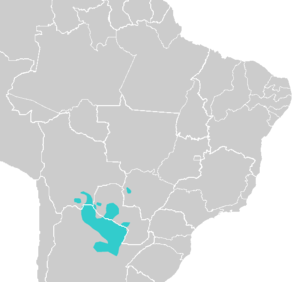Mataco–Guaicuru languages
Mataco–Guaicuru or Macro-Waikurúan is a hypothetical language family consisting of the Guaicuruan, Matacoan, and sometimes Mascoian and Charruan families. These are spoken in Argentina, Brazil, Paraguay, and Bolivia.
| Mataco–Guaicuru | |
|---|---|
| Macro-Waikurúan | |
| (obsolete?) | |
| Geographic distribution | South America |
| Linguistic classification | Proposed language family |
| Subdivisions | |
| Glottolog | None |
 | |
Kaufman (2007: 72) also adds Lule–Vilela and Zamucoan to the family.[1]
Genetic relations
Jorge Suárez linked Guaicuruan and Charruan in a Waikuru-Charrúa stock. Morris Swadesh proposed a Macro-Mapuche stock that included Matacoan, Guaicuruan, Charruan, and Mascoyan. Terrence Kaufman (1990, 1994) said this proposal, which he called Macro-Waikurúan, deserved to be explored, but Campbell (1997) said that for the present it should not be accepted as anything more than a possibility, and Campbell (2012) said he no longer intends to evaluate it.[2]
Classification
Internal classification by Jolkesky (2016):[3]
(† = extinct)
- Macro-Mataguayo-Guaykuru
Chaco linguistic area
Campbell and Grondona (2012) consider the languages to be part of a Chaco linguistic area. Common Chaco areal features include SVO word order and active-stative verb alignment.[4]
See also
References
- Kaufman, Terrence. 2007. South America. In: R. E. Asher and Christopher Moseley (eds.), Atlas of the World’s Languages (2nd edition), 59–94. London: Routledge.
- Campbell, Lyle (2012). "Classification of the indigenous languages of South America". In Grondona, Verónica; Campbell, Lyle (eds.). The Indigenous Languages of South America. The World of Linguistics. 2. Berlin: De Gruyter Mouton. pp. 59–166. ISBN 9783110255133.
- Jolkesky, Marcelo Pinho De Valhery. 2016. Estudo arqueo-ecolinguístico das terras tropicais sul-americanas. Ph.D. dissertation, University of Brasília.
- Campbell, Lyle; Grondona, Verónica (2012). "Languages of the Chaco and Southern Cone". In Grondona, Verónica; Campbell, Lyle (eds.). The Indigenous Languages of South America. The World of Linguistics. 2. Berlin: De Gruyter Mouton. pp. 625–668. ISBN 9783110255133.
- Greenberg, Joseph H. (1987). Language in the Americas. Stanford: Stanford University Press.
- Kaufman, Terrence. (1990). Language history in South America: What we know and how to know more. In D. L. Payne (Ed.), Amazonian linguistics: Studies in lowland South American languages (pp. 13–67). Austin: University of Texas Press. ISBN 0-292-70414-3.
- Kaufman, Terrence. (1994). The native languages of South America. In C. Mosley & R. E. Asher (Eds.), Atlas of the world's languages (pp. 46–76). London: Routledge.